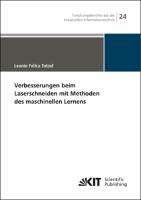Verbesserungen beim Laserschneiden mit Methoden des maschinellen Lernens
Dissertations in Series (Dissertationen in Schriftenreihe)
| dc.contributor.author | Felica Tatzel, Leonie | |
| dc.date.accessioned | 2022-02-18T15:02:45Z | |
| dc.date.available | 2022-02-18T15:02:45Z | |
| dc.date.issued | 2022 | |
| dc.identifier | ONIX_20220218_9783731511281_17 | |
| dc.identifier | OCN: 1308751182 | |
| dc.identifier.issn | 2190-6629 | |
| dc.identifier.uri | https://library.oapen.org/handle/20.500.12657/52956 | |
| dc.language | German | |
| dc.relation.ispartofseries | Forschungsberichte aus der Industriellen Informationstechnik | |
| dc.subject.classification | thema EDItEUR::T Technology, Engineering, Agriculture, Industrial processes::TH Energy technology and engineering::THR Electrical engineering | en_US |
| dc.subject.other | cut quality | |
| dc.subject.other | convolutional neural network | |
| dc.subject.other | machine learning | |
| dc.subject.other | stainless steel | |
| dc.subject.other | Laser cutting | |
| dc.subject.other | Schnittqualität | |
| dc.subject.other | Maschinelles Lernen | |
| dc.subject.other | Edelstahl | |
| dc.subject.other | Laserschneiden | |
| dc.subject.other | Faltendes neuronales Netz | |
| dc.title | Verbesserungen beim Laserschneiden mit Methoden des maschinellen Lernens | |
| dc.type | book | |
| oapen.abstract.otherlanguage | Although laser cutting of metals is a well-established process, there is considerable potential for improvement with regard to various requirements for the manufacturing industry. First, this potential is identified and then it is shown how improvements could be made using machine learning. For this purpose, a database was generated. It contains the process parameters, RGB images, 3D point clouds and various quality features of almost 4000 cut edges. | |
| oapen.identifier.doi | 10.5445/KSP/1000137690 | |
| oapen.relation.isPublishedBy | 44e29711-8d53-496b-85cc-3d10c9469be9 | |
| oapen.relation.isbn | 9783731511281 | |
| oapen.collection | AG Universitätsverlage | |
| oapen.imprint | KIT Scientific Publishing | |
| oapen.series.number | 24 | |
| oapen.pages | 234 | |
| oapen.place.publication | Karlsruhe | |
| peerreview.anonymity | All identities known | |
| peerreview.id | 51a542ec-eaeb-47c2-861d-6022e981a97a | |
| peerreview.open.review | No | |
| peerreview.publish.responsibility | Books or series editor | |
| peerreview.review.stage | Pre-publication | |
| peerreview.review.type | Full text | |
| peerreview.reviewer.type | Editorial board member | |
| peerreview.reviewer.type | External peer reviewer | |
| peerreview.title | Dissertations in Series (Dissertationen in Schriftenreihe) |

